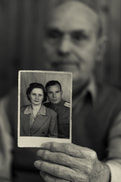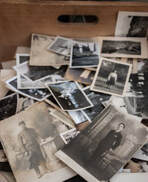
My cup overflows with ideas to share with you on our story capturing journey. It’s not hard to find an idea, it’s difficult to choose one. Today’s Reflection comes from Diane, a student in a Legacies family history writing class. When asked for take-aways from the class, Diane said with a new sense of urgency these four words:
Interview First. Research Later.
In the class we talk about the importance of interviewing in the research process, especially with those in the later stages of their life. But those four words brought the 30 minute message home.
Interview First. Research Later.
The point being that archives, libraries, historical societies and internet resources will remain available to us for a long time into the future and over time will grow and possibly provide us with more access to our roots.
But today, at this point in history, the living person with first-hand accounts and possible memories - may not.
I love quotes that jump start my thinking about a particular topic. One that came across my desk recently did just that. “The most important people in our lives are there when we’re born, and there when we die.” This year those words hang heavy in my heart. Today, anyone reading this understands its new implications.
Interview First. Research Later.
The explosion of internet research tools has made it simple for us to spend hours on end searching for our ancestors. Today’s message pleads with you to step away from the screen and go face-to-face in whatever form you can and is available to you.
Here are Tips to consider before you begin any interview.
1. Know your storyteller. Preparing for the upcoming interview is more than simply turning on a recording device. It takes preparation. We must remember not to stereotype an entire generation of seniors. Don’t assume that your storyteller has their memories intact, that a 97-year-old will bring up names and dates as though it was yesterday. Or they may just surprise you.
At times, we assume elder narrators have all their faculties, and that their health and wellbeing are stable enough to relive moments, ready for our well-meaning queries. Remember, that there are many living with age-related memory-robbing and life-robbing diseases, who struggle to unlock earlier lives.
If your storyteller is struggling with memory loss, use props that can be seen or held. Turn off the video camera if it is intimidating. Sit close. Hold hands if appropriate. Begin with your eldest family members, whether they live near or far. Use online technology to access your storyteller from a distance.
2. Questions. Some storytellers prefer questions or may need prompts to journey back. Most often, the frequently told stories are told first. Take this time to pull back the layers of those well-known accounts through the senses of sight, sound, smell, touch or taste.
Avoid starting with, “tell me about your childhood.” Open-ended questions are too large an ocean for any individual to uncover and at times, can feel overwhelming. Instead, ask specific questions. Internet sites abound with just such lists to help surface stories of ancestors, childhood, teen, middle and senior years, times of schooling, love, marriage, parenthood and military.
Maybe start by asking about the home they grew up in? What is their earliest memory? What do they remember of their parents in that house? In
years past, many extended families lived together, so they may have stories of their grandparents, your great grandparents.
If possible, forward the questions to the storyteller before your session so they can review them and think about the answers before your time together.
3. Style. Each storyteller has their own unique style. Some individuals share their life chronologically, while others jump from story to story, leaving the connecting of the dots to future writing. Be flexible.
4. Who to involve? If the ‘telling’ is in a group setting encourage each storyteller to speak. Be respectful but careful of others who jump in to finish a story, add their own take or correct information. If there is a primary storyteller, always shift the ‘telling’ back to that individual. Let the individual have your full attention, without interruptions or embellishments.
Group interviews can be helpful because they prompt shared memories, valuable for some, but distracting for others. Such interviews, if done with peers, can provide reminders of people, places and events.
An aging person may get lost in a group setting, possibly out of respect for others, an inability to hear the threads, or may be introverted by nature.
Group interviews can be successful but are also difficult to transcribe if voices are not identified. Again, make sure the focus is on the primary storyteller, asking others to become active listeners. Maybe suggest that they write down their questions or ideas to present at a later time.
5. Involve generations. Encourage younger family members to hear stories first-hand. Make it a memorable family affair. Ask relatives what stories or clarifications they’d like to hear. Keep in mind however, that too many people or questions can create confusion for an older adult.
6. Time. Find a time when your narrator is most alert. Depending on the storyteller, 60 – 90 minute time frames work well with a bathroom, snack or picture break. Give the interviewee the appropriate time. Don’t rush. And be careful never to pressure anyone to remember.
7. Location. Find a space that is free of noise. Something as simple as a ceiling fan creates ambient noise when in a recording. Many elders find it hard to hear and concentrate in environments with distracting noises and windows to the outside.
8. Equipment. As we know, technology is everywhere. No matter how simple or sophisticated your recording equipment, have backup batteries and alternate devices. No one likes to lose that cherished interview. Transcribe oral histories. The choice is not “oral or written”, it’s both. You can’t know what future generations will need or want. Today, creativity plays a huge role. Even if it’s sitting outside a window and talking through your phones - Capture the story … before it’s too late.
9. Photos. Take along that box of unknown photos for identification. You’ll be glad you did.
Beware. In our world of electronic sharing, don’t assume that it’s okay to put an interview online. Get permission from the storyteller or his/her guardian. Protect the individual and your family history. Keep it close to home.
Most of all, remember that this event is not a one-time event. Schedule consistent storytelling and story-gathering time. Your Mondays with Gramma Cora or Fridays with Frank will remain as some of the most memorable of your life.
Join me for a recorded Story-By-Story video journey as we provide hints for organizing photos, researching your family history, and writing and producing a family keepsake. https://www.facebook.com/legaciesstories. For other Legacies learning opportunities including two in-depth online classes entitled: The Making of a Family Historian and Guided Autobiography visit: legaciesstories.com/classes.
I'LL BE SEEING YOU IN ALL THE OLD FAMILIAR PLACES.
~ Mary






